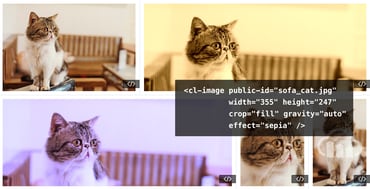Even though websites have changed dramatically over the years – from simple text-based pages to advanced in-browser apps full of images and videos – the underlying HTTP protocol really hasn’t changed - until recently, with the approval of the HTTP/2 protocol by the IETF. Today Cloudinary is proud to announce, as part of a CDN infrastructure upgrade, general availability of HTTP/2 support in our image and video management solution. This will help you optimize the user experience on your app or website even more.

Once upon a time, in long forgotten browser versions, getting a video into a website required creating and embedding Flash resources. But these days, all modern browsers support HTML5, including the HTML5 <video> tag, which means you’ve got a built-in video player that anyone can use.

I'll start by giving it to you straight:
As part of the recent "auto–everything" launch, we introduced two new transformation parameters – dpr_auto and w_auto, which pair the DPR and Width Client Hints with Cloudinary’s existing image resizing and delivery infrastructure, in order to serve up simple, automatic responsive images.

One of the most important things to know about compressing image files is that a smaller file size comes at the cost of a lower image quality. How much lower, and whether low enough to make a difference visually, depends on the image. Compression can be very effective at reducing the size of the image, and besides lowering the costs of storage space and bandwidth, a reduced image size goes a long way to retaining your users’ attention with faster, smaller downloads.

The Rolling Stones claim, “You can’t always get what you want”.
And when your application needs to crop hundreds or thousands of images to specific sizes within a strictly defined UI design, that frustrating Rolling Stones phrase may be ringing in your ears.
But maybe it doesn’t have to.


In part one (One pixel is worth three thousand words) of this turned-to-be-two-part blog post, I discussed one-pixel images and how well different image formats “compress” these images. I was surprised how much there is to be said about the matter. This was supposed to be a short blog post, describing one-pixel images and how they compress, and instead it became a glorious monster (and also a two part blog post…).
A couple of months ago while taking a break from implementing cool new features like q_auto and g_auto, I was joking in our team chat about how well various image formats “compress” one-pixel images. In response, Orly — who runs the blog — asked me if I’d write a post about single-pixel images. I said: "Sure, why not. But it will be a very short blog post. After all, there’s not much you can say about a single pixel."

